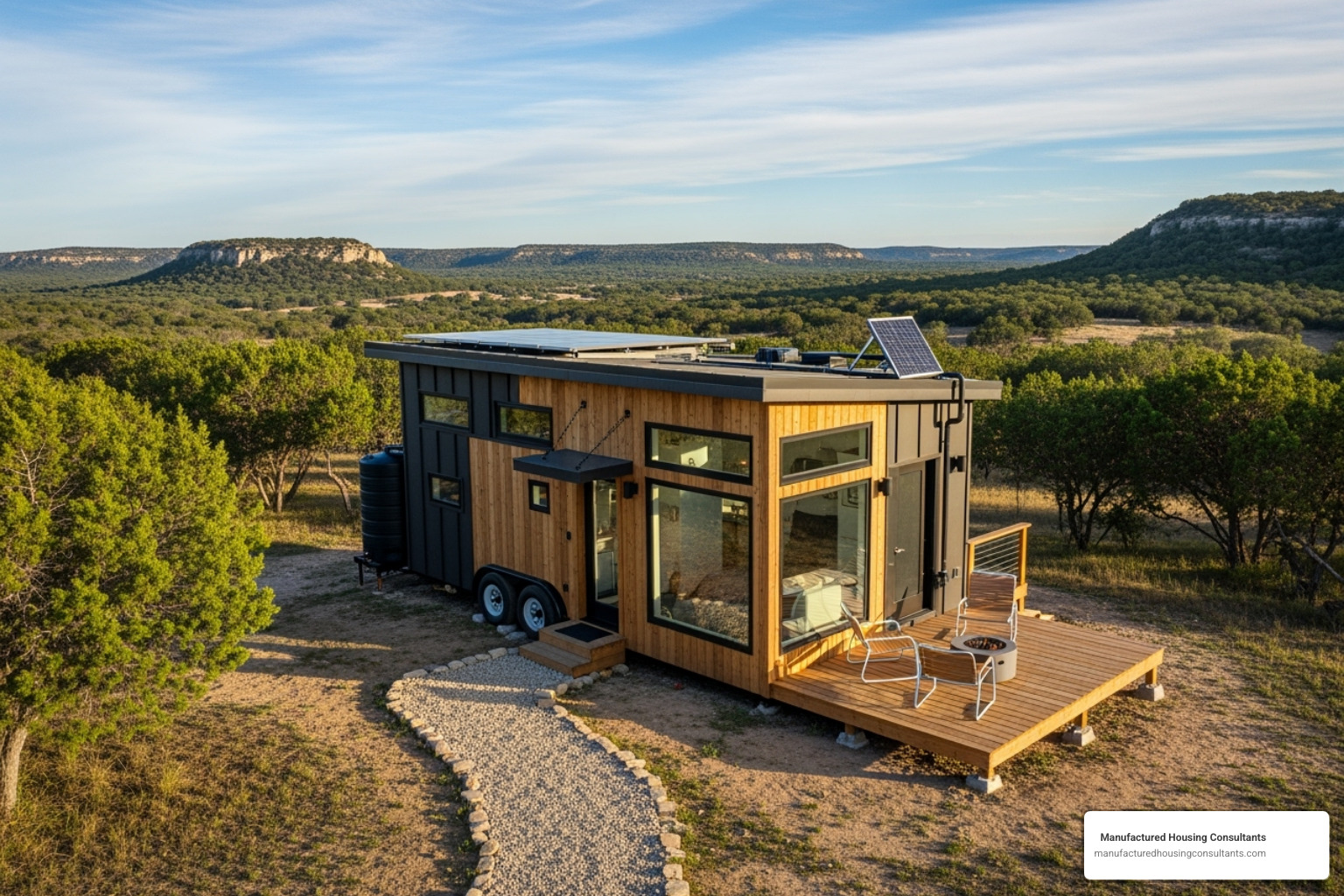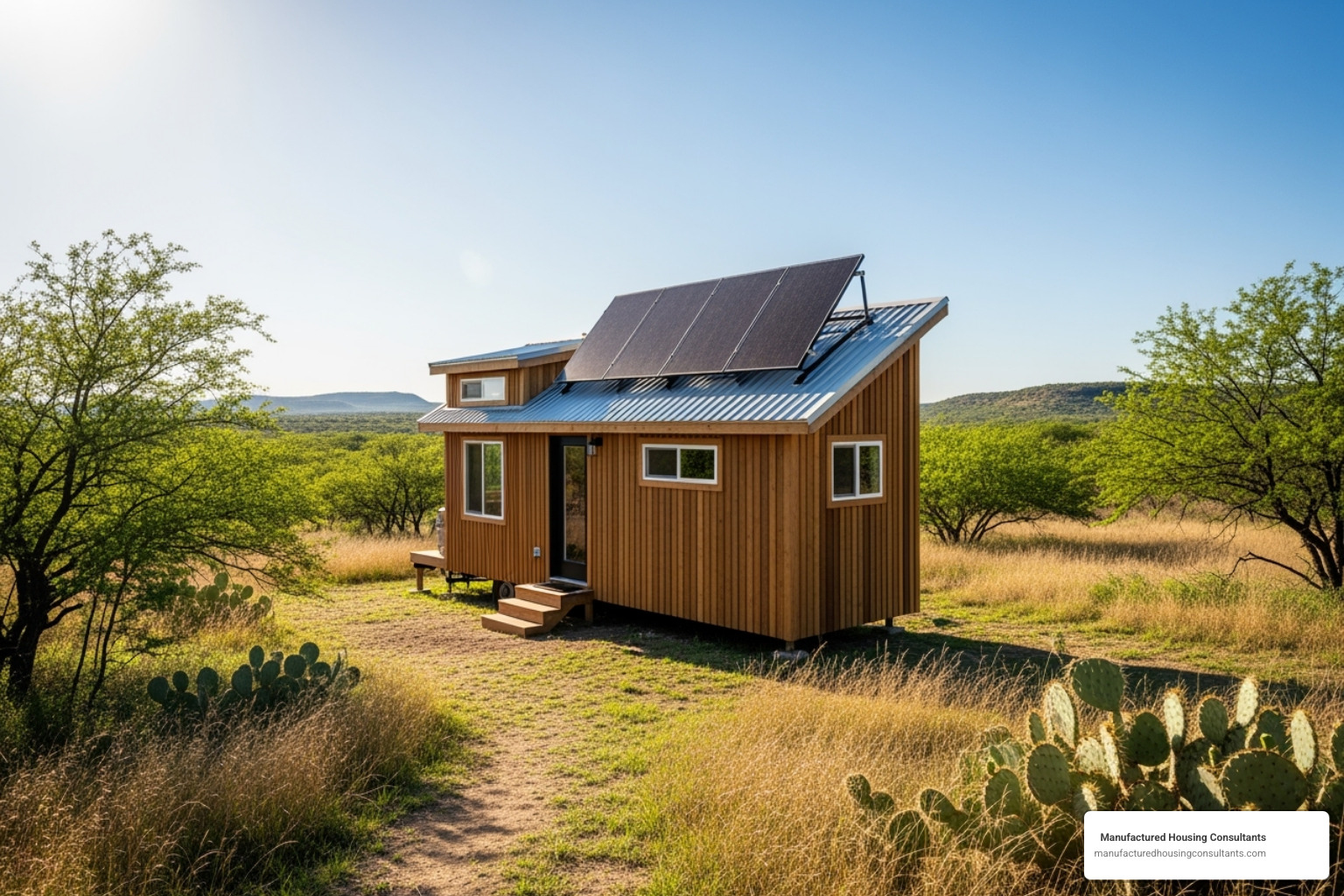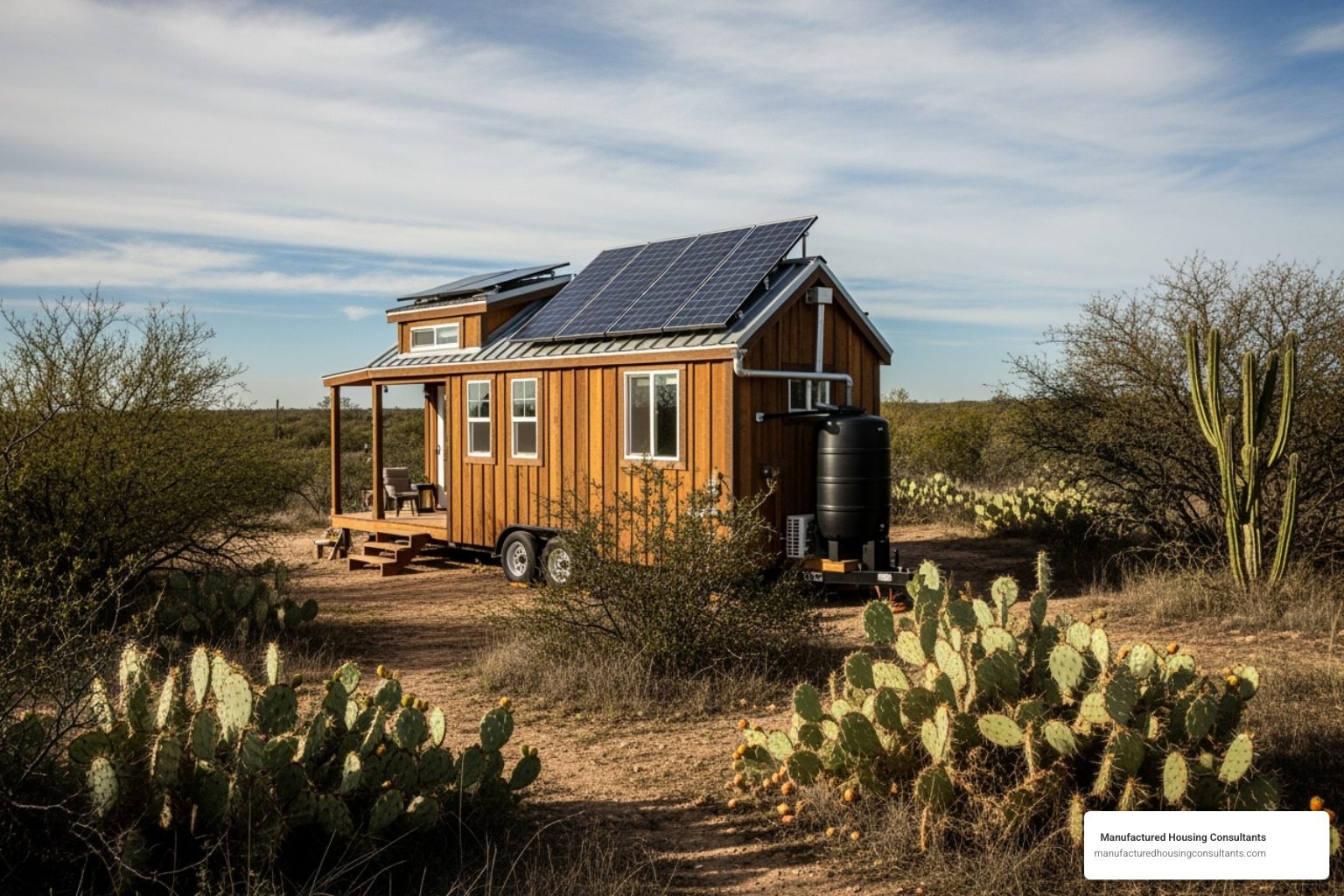The Rise of the Off-Grid Tiny House in Texas
An off grid tiny house is a small, self-sufficient home (typically 100-400 square feet) that operates independently from traditional utilities like electricity, water, and sewage systems. These homes use renewable energy sources like solar power, collect rainwater, and manage waste through composting toilets or septic systems.
Key features of off-grid tiny houses:
- Solar power systems with battery storage
- Rainwater collection and filtration systems
- Composting toilets or greywater management
- Propane heating and cooking systems
- High-efficiency insulation and design
- Mobility options on wheels or permanent foundations
The tiny house revolution is sweeping across Texas, and it’s easy to see why. With traditional housing costs soaring – the average home in San Antonio now costs over $300,000 – more Texans are finding the freedom that comes with downsizing to an off-grid tiny house.
Living off-grid means true independence. No monthly utility bills. No dependence on the electrical grid. No water bills that keep climbing higher each year.
According to our research, homeowners can save thousands of dollars annually by eliminating utility bills, while the initial investment in an off-grid tiny house is significantly lower than a traditional home. Some Texas tiny house owners report spending as little as $25,000 to build their dream home themselves, while quality prefab options start around $80,000.
At Manufactured Housing Consultants, we’ve seen growing interest from young families and individuals across Texas who want affordable, sustainable housing solutions. While we provide the tiny home structure, it’s important for buyers to understand that the off-grid components—like solar panels and water systems—are sourced and installed separately. Whether you’re in San Antonio, Austin, or the Hill Country, an off-grid tiny house offers the chance to own your home outright – often within just two years instead of carrying a 30-year mortgage.
The best part? You’re not just saving money. You’re gaining the freedom to live anywhere you want in Texas, reduce your environmental impact, and simplify your life in ways that seemed impossible just a few years ago.
Simple guide to off grid tiny house terms:
Your Blueprint for Off-Grid Success
Building your dream off grid tiny house in Texas offers benefits beyond cost savings, including financial freedom, a reduced environmental footprint, and incredible mobility.

The financial advantages are compelling. An off-grid tiny house can be paid off in as little as two years, a stark contrast to a 30-year mortgage. The real game-changer is having zero utility bills, saving thousands of dollars annually. Our clients from Victoria to Laredo confirm these substantial savings. The environmental benefits are also significant. A smaller space requires less energy, and when paired with solar panels, you can achieve a near-zero carbon footprint. Finally, mobility with a tiny house on wheels means you’re not tied to one location. You can relocate for work or a change of scenery without the stress of selling a traditional home.
INFOGRAPHIC: The Power of Off-Grid Tiny Living in Texas
Cost Savings
- Average Tiny House Cost: $30,000 (significantly less than traditional homes)
- Pay Off Your Home in ~2 Years (vs. 30-year mortgage)
- Save Thousands Annually (Zero Utility Bills!)
Environmental Impact
- Less Energy for Heating/Cooling
- Reduced Carbon Footprint (Zero Emissions with Renewables)
- Mindful Resource Consumption
Mobility & Flexibility
- Live Anywhere in Texas (Zoning Permitting)
- Easily Relocate for Work or Trip
- Freedom from Traditional Housing Constraints
More info about Tiny Homes Benefits and Features
Essential Systems for Self-Sufficiency
A self-sufficient off grid tiny house means you are your own utility company. To clarify, while Manufactured Housing Consultants provides the tiny home, we do not offer the following off-grid systems. Homeowners will need to source these components to complete their setup. With proper planning, these systems work together seamlessly.

Solar power is the heart of most off-grid homes. A system includes solar panels, an inverter, charge controllers, and a battery bank to store energy for cloudy days or nighttime use. Sizing your system correctly is crucial. Calculate your daily energy needs by listing all appliances and their usage. In Texas, plan for summer heat and the shorter daylight hours of winter.
For heating, wood stoves offer efficient, ambient heat and can also be used for cooking. Propane is another practical option for cooking, water heating, and backup heat, valued for its portability and reliability.
Water management involves rainwater harvesting from your roof into storage tanks, which requires proper filtration for safe consumption. Alternatively, drilling a well provides a consistent water supply but at a higher upfront cost. Conservation becomes key, with low-flow fixtures and mindful usage.
Waste management includes composting toilets, which convert waste into compost without using water, and greywater systems that reuse water from sinks and showers for irrigation. These systems eliminate the need for a traditional septic system and reduce water consumption.
More info about Inexpensive Tiny Homes
Designing an Efficient Off-Grid Tiny House in Texas
Designing an off grid tiny house for Texas requires balancing aesthetics with functionality, especially within a 100-400 square foot space.

Smart space utilization is key. Use multi-functional furniture, like sofa beds, and maximize vertical storage with wall-mounted shelves and hooks. Creative solutions like under-stair compartments and bed platforms with drawers are essential. Using light colors and large windows can make the space feel larger. Before building, use masking tape on the floor to map out your layout and ensure it’s practical.
For climate efficiency in Texas, passive solar design is vital. Orient your home to maximize winter sun and provide summer shade. High R-value insulation like Structural Insulated Panels (SIPs) is non-negotiable for handling both heat and cold. Proper ventilation with cross-ventilation and exhaust fans is also crucial to prevent moisture buildup and maintain air quality.
Top 5 Space-Saving Design Tips for Texas Tiny Homes:
- Go Vertical – Use walls for shelving, hanging storage, and mounted appliances
- Multi-functional Magic – Invest in furniture serving multiple purposes
- Lofty Dreams – Incorporate lofts for sleeping or storage, separating living areas
- Built-in Brilliance – Design custom storage under stairs, in window seats, or awkward corners
- Light & Bright – Use light colors and maximize natural light for an open, airy feel
More info about Tiny House Floor Plans
Navigating Costs and Legalities
Understanding the financial and legal landscape is crucial for your off grid tiny house journey in Texas.
Cost comparisons show the appeal of tiny living. DIY builds can cost $25,000-$30,000, while prefab models range from $80,000 to over $100,000. The real savings, however, come from eliminating utility bills. At Manufactured Housing Consultants, we offer financing for manufactured homes that can be adapted for off-grid living, providing an affordable path to homeownership.
TABLE: Estimated 5-Year Cost Comparison (San Antonio, Texas)
| Expense Category | Off-Grid Tiny House (MHC Prefab – est. $80,000) | Traditional San Antonio Apartment Rental |
|---|---|---|
| Initial Investment | ~$80,000 (can be financed) | ~$1,500 (Security Deposit) |
| Monthly Utilities | $0 | ~$200 – $300 |
| Monthly Rent/Loan | Varies (low if paid off quickly) | ~$1,500 |
| Annual Maintenance | ~$500 | Minimal (Landlord responsibility) |
| 5-Year Total | ~$80,000 – $85,000 (plus land cost) | ~$102,000 – $108,000 (no equity) |
Legal and zoning considerations are often the most complex part. Many building codes have minimum size requirements that tiny homes don’t meet. Tiny Houses on Wheels (THOWs) are often classified as RVs, which can provide a legal pathway around these rules. RVIA certification is important as it ensures your THOW meets safety standards, helping it gain recognition as a vehicle.
Texas county regulations vary widely. Rural areas near Von Ormy or Laredo may have more lenient rules, but research specific county and municipal ordinances. Land ownership is key to true off-grid freedom, allowing you to install the necessary systems without external dependencies.
Overcoming Challenges and Finding Inspiration
Living in an off grid tiny house is rewarding, but it’s important to understand the challenges and learn from others’ experiences.
Common challenges include system maintenance (you’re the expert), limited space requiring constant organization, and careful resource management of power and water. You’ll also face weather dependency for solar and water collection and potential isolation in remote areas.
Real-world success stories prove these challenges are surmountable. People have lived off-grid for years, using solar power, rainwater, and even biogas from waste. Others have converted sheds or built small cabins for under $20,000, proving that off-grid living is accessible at different budget levels.
To thrive, plan carefully and gain knowledge about your systems before you build. Volunteering with organizations like Habitat for Humanity can provide invaluable hands-on experience. Start small, perhaps with a used RV, to test the lifestyle. Prioritize quality in essential systems like solar and water pumps to avoid costly failures later. Finally, accept the learning curve and build for the Texas climate with excellent insulation and passive cooling strategies.
Accept Your Freedom in Texas
The journey to an off grid tiny house is a path to true independence and financial freedom. With careful planning and the right foundation, this dream is achievable for Texans ready to accept a different way of living. The numbers speak for themselves: an off-grid tiny house can be paid off in just a few years, leaving you debt-free and independent from utility bills and rent increases.
At Manufactured Housing Consultants, we understand the growing desire for housing that offers real value and freedom. While we specialize in manufactured and mobile homes, we recognize that our clients are looking for foundations that can support their off-grid dreams. Our homes can be adapted to integrate the solar, water, and waste systems that make this lifestyle possible. To be clear, we do not sell or install these off-grid systems; our expertise lies in providing the high-quality home that serves as your starting point.
We serve communities across Texas—from San Antonio and Von Ormy to Corpus Christi and Laredo—with a commitment to the lowest prices and statewide delivery. Your vision of an off-grid lifestyle doesn’t have to remain a dream, no matter where in Texas you want to plant your roots.
The sustainable future you imagine is within reach. The technology exists, financing is available, and the legal paths are navigable. Your freedom is waiting. The question isn’t if off-grid living is possible in Texas—it is. The question is if you’re ready to take the first step.





